by Rachel Obbard
One of my many hats is that of a glaciologist – I study the material properties of ice and snow and how microstructure (of individual ice crystals) affects macrostructural properties (i.e. glacier movement).
This winter, I’m working in Antarctica – eventually out at a deep field camp on the West Antarctic Ice Sheet – but for now, at the main U.S. Antarctic Program (USAP) base at McMurdo Station. With interests in materials processing, recycling, and sustainability – and some unplanned time on my hands due to flight cancellations – I recently decided to visit McMurdo’s waste handling facilities.
About McMurdo Station
McMurdo Station (77° 51” S, 166° 40” E) is roughly 2,415 miles south of Christchurch, New Zealand (where our flights originate) and 850 miles north of the South Pole, where the U.S. has a much smaller base. McMurdo Station was built in 1955 on the bare volcanic rock of Ross Island, the farthest point South that is accessible by ship and the landing spot of early explorers – James Clark Ross, Robert F. Scott and Ernest Shackleton.
 A look at the "town" of McMurdo from Ob Hill.
A look at the "town" of McMurdo from Ob Hill.
The location’s accessibility by sea is highly seasonal. The Ross Sea freezes 1-2 meters thick for as far as 50 miles from the Station for 10 months of the year, and McMurdo is only accessible by ship for a short time in the austral summer. A supply ship docks on a floating ice pier in January, and leaves a week later with all of the waste generated by the U.S. Antarctic Program.
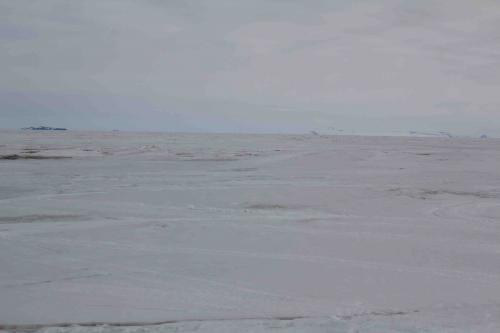 Right now, the ice extends as far as the eye can see. In a few weeks, it will break up and recede back into the sea.
Right now, the ice extends as far as the eye can see. In a few weeks, it will break up and recede back into the sea.
Garbage Rules
Waste management is logistically challenging in Antarctica because of the cold, windy climate, strict environmental regulations, difficult working conditions and remoteness from processing facilities, landfills and recyclers.
The annual mean temperature in McMurdo is 0°F, but temperatures can get as low as –58°F in the winter and as high as 46°F in the summer. The average wind is 12 knots (13.8 mph), but winds can exceed 100 knots (115 mph). Anything that can blow will blow. Although there is not a lot of snowfall, the winds generate enormous drifts.
The Antarctic Treaty’s Protocol on Environmental Protection states that member nations will reduce the amount of waste produced in Antarctica and return all wastes to the country that generated the wastes – to the maximum extent practicable. This means that all USAP waste is shipped back to the U.S. – specifically Port Hueneme, a naval base near Santa Barbara, CA. Fortunately, most of the end vendors (recyclers for the various types of waste) are located just blocks away from the port.
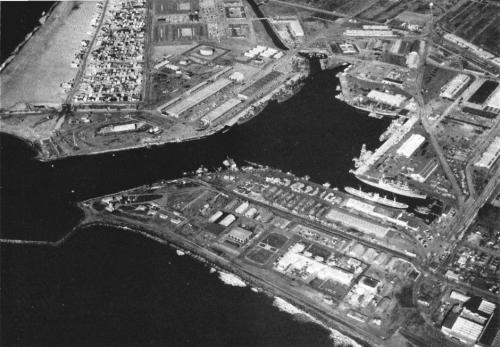 Aerial picture of Port Hueneme, California. Photo credit: Wiki commons.
Aerial picture of Port Hueneme, California. Photo credit: Wiki commons.
Waste handling and recycling decisions in Antarctica involve the same considerations as in municipal solid waste districts – economies of scale, transport costs, raw material prices, and availability of recycling facilities – but are made far more complex by the nature of the Antarctic Program. Shipping is extremely long distance, limited to one ship full, and takes place only once per year. Economies of scale can be realized at McMurdo Station, which can host as many as 1300 people during the summer months (December-January), but facilities and labor at the South Pole and field camps are quite limited (and the weather often worse). Extra steps, such as waste consolidation (i.e. can crushing or baling) don’t take place there, so waste shipped to McMurdo from these sites can’t be combined with the rest of the waste stream. This affects the prices they can command and therefore the funds coming back to Antarctica.
Because of the geopolitical complexity of the situation, the regulations in play include not only those stemming from state (California) and Federal (i.e. EPA, DOT) statutes on the handling, shipment, import and export of waste, but from the Antarctic Treaty itself as well as from international shipping regulations.
Then of course, there are the economic arguments for recycling. The more money the program can make from high quality recycled materials, the less the waste management costs and the more can be spent on other parts of the US Antarctic Program (science for instance).
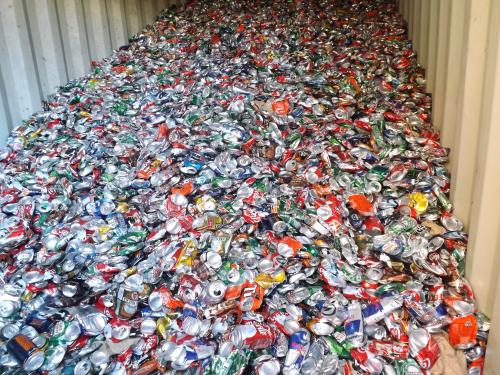 Just outside the Waste Barn is a container for crushed aluminum cans. Crushed cans command higher prices, but may not be worth the cost of hiring additional summer staff to crush them.
Just outside the Waste Barn is a container for crushed aluminum cans. Crushed cans command higher prices, but may not be worth the cost of hiring additional summer staff to crush them.
The Facilities
“Waste James” (people go by their department here) graciously showed me the waste management facilities at McMurdo, which included the Waste Barn (indoor operations) and Fortress Rocks (outdoor). Members of the community (scientists and support staff) sort their own trash into mixed paper, plastics, cardboard, glass, aluminum, other metals, paper towels, food waste, batteries, biowaste, and electronic scrap. Most of it, 65%, is recycled.
 The recycling bin in our dorm, with 12 compartments for the different categories of waste. We take an orientation upon arrival, just to learn how to sort our trash correctly!
The recycling bin in our dorm, with 12 compartments for the different categories of waste. We take an orientation upon arrival, just to learn how to sort our trash correctly!
The Waste Barn
The Waste Barn is a 1950s era Quonset hut heated with waste oil and fuel. (A combination of the two is required because in this climate the oil alone would be too viscous.) The Waste Barn houses a cardboard baler and containers for collecting and baling mixed paper, paper towels and plastics.
 The Waste Barn is the indoor facility where lightweight wastes are sorted and prepped for shipping, including cardboard, paper towels, etc.
The Waste Barn is the indoor facility where lightweight wastes are sorted and prepped for shipping, including cardboard, paper towels, etc.
Cardboard, 800,000 pounds of it last year, is a major part of the waste stream because everything that comes to Antarctica and is shipped between McMurdo and the field sites is packaged in cardboard boxes. We packed for the field last week and assembled two 50 cubic foot triwall (triple thickness) cardboard boxes on pallets.
 Three layers of cardboard visible within the wall.
Three layers of cardboard visible within the wall.
These rugged “triwalls” are used for everything, both on continent and between here and the U.S. There are also smaller corrugated cardboard boxes, the type that soda pop (for example) comes in. The cardboard baler is old and requires workers to load the conveyor belt by hand from dumpsters brought in from all over the station. There are separate dumpsters for each type of waste outside the 8 or 9 dorms, the dining hall (“Galley”), the science building, the cargo and field operations buildings and all of the other main buildings. The waste department has three heavy equipment operators, who bring the dumpsters to the barn, where five people sort and bale it.
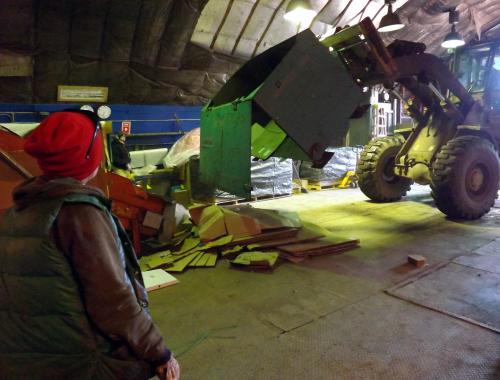 A forklift drops cardboard from the dumpsters around the station into the middle of the Waste Barn floor.
A forklift drops cardboard from the dumpsters around the station into the middle of the Waste Barn floor.
 Employees load the cardboard by hand onto a conveyor belt, which feeds it into a baler.
Employees load the cardboard by hand onto a conveyor belt, which feeds it into a baler.
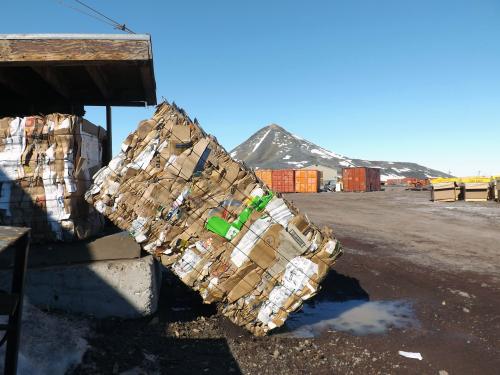 The baler pushes out a compact bale of cardboard, tied up and ready for shipping.
The baler pushes out a compact bale of cardboard, tied up and ready for shipping.
Mixed paper and plastics are bagged and put into a box or dumpster sack. The latter look like giant Ikea bags (polypropylene). They cost $25 each, half of what the triwall box and pallet combination do. But more importantly, a shipping container can deliver 500 dumpster bags to McMurdo or the South Pole, versus only 40 large triwall boxes and pallets. The Waste crew struggles to find effective means to move the full bags though. Their uneven shapes and topside handles are much trickier than pallets for the fork lifts.
The program used to collect white paper separately from other types, but it was never clean enough for the recyclers. So now the lower value mixed paper category is used. Paper towels are collected and baled separately though, because they are headed to a landfill. The paper towel bins admonish users to include, “Paper towels and all bale-able items including: tissues, napkins, clean candy wrappers, paper cookie trays, “crinkly” plastic, and rubber gloves.” It might seem odd to include light plastic with paper towels, but this is done to combine and safeguard all types of waste that could be lofted out of containers by the wind.
 Paper towel baler.
Paper towel baler.
Fortress Rocks
Wood – mostly pallets and crates – is piled up in the Fortress Rocks area above ‘town, and is eventually fed into an 8 foot diameter grinder. The conditions required for grinding (working grinder, working picker, and no wind) mean that the grinder only operates about 5 days a year, but when it does, it churns out many containers full of wood chips. The wood chips go into containers and these go on the ship back to Port Hueneme for recycling.
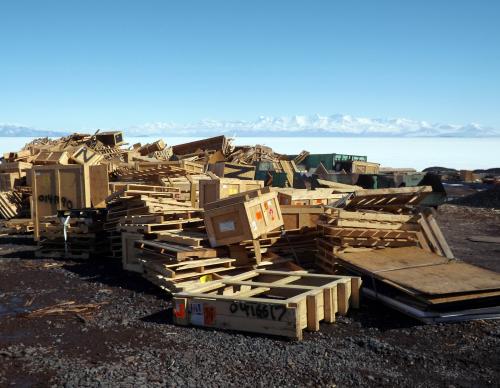 Wood pile in Fortress Rocks, with the Transantarctic Mountains in the background.
Wood pile in Fortress Rocks, with the Transantarctic Mountains in the background.
 Giant grinder churns out wood chips.
Giant grinder churns out wood chips.
In the future, the program plans to install woodchip boilers that use a combination of wood chips, paper and food waste to heat the buildings. These are self-contained and could be moved from building to building as parts of the aging infrastructure at McMurdo are rebuilt.
Also in Fortress Rocks is a metal crusher. Metal, separated into ferrous and non ferrous, is crushed and the bales placed in shipping containers. Because of their awkward shapes, they don’t pack neatly.
 Crushed steel cans.
Crushed steel cans.
There is also a solar cooker for fuel-contaminated dirt up in Fortress Rocks. To preserve the environment, every spill in Antarctica has to be cleaned up, no matter how small. When fuel is spilled or equipment leaks, the contaminated dirt is shoveled up and bagged. Two to three days of cooking removes the volatiles and the dirt can be returned to Ross Island, eliminating the need to ship all contaminated dirt back to the U.S. for disposal, as was done many years ago. Apparently these dirt cookers are seeing increased popularity in other places as well, as a result of the fracking industry.
McMurdo Sound is deep enough for the ship to get quite close to the station, and loading is done from an ice pier that is constructed every year from the sea ice that forms over the winter. Ice piers don’t last forever, though! Last year the pier broke in three pieces during a particularly violent storm while the vessel was docked and loading! The heavy equipment, vehicles and workers had to retreat before the work was done, and the ship had to leave only half full. This meant that 14 containers of food waste and several more of hazardous waste were left behind to overwinter. The food waste (double-bagged and boxed) is in leased reefer (refrigerator) containers that are not designed to be left out in this climate for 10 months. They will be shipped back to Port Hueneme this year, but before they are, workers need to make sure the refrigeration is working.
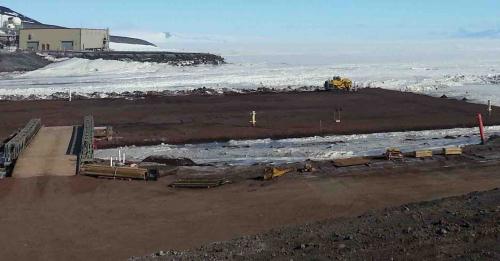 The dirt is spread over the ice to create a temporary pier, where a boat will dock for exactly one week, once the sea ice recedes.
The dirt is spread over the ice to create a temporary pier, where a boat will dock for exactly one week, once the sea ice recedes.
The food waste is one of the most difficult parts of the waste stream to handle. Most of the food imported to McMurdo comes from the U.S., but we do get some produce from New Zealand, which is much closer. There are strict import regulations on agricultural products generally (in many nations) and the California agricultural lobby in particular doesn’t want viable seeds being brought in from overseas. As it turns out, the USAP food waste isn't even processed in California. It’s very wet, as food waste goes (all the canned goods? All the liquids we’re encouraged to drink that get partially dumped?) and about ten years ago, it extinguished the flame in the California’s incinerator. Waste James says, “They haven’t forgotten it.” So unlike all of the other waste products, the food waste is trucked to Washington state for disposal. But in order to get there, it has to be trucked through California, and remain below -23C the whole way.
If the refrigeration on a reefer doesn't work, the entire container, 70 large triwall boxes of food waste, needs to be unloaded and repacked into a working reefer. At above freezing temperatures, a messy business.
Hazardous Waste
There are 250 categories of hazardous waste, including everything from motor oil to biowaste, to chemicals used by scientists. Each type has its own packing and labeling requirements, right down to where they can be stored on the vessel when they are shipped out. Small containers (e.g. bottles) are contained in larger ones (e.g. drums), these are packed in boxes, and those in shipping containers. Every container used is labeled, with the type of waste and the date. Because the vessel had to leave suddenly last year, half of the hazardous waste load was left here. Each container, box and drum now has to be unpacked so that every container, down to small pint-sized ones, can be relabeled, before it can be shipped out this year.
Recycling
A lot of creative recycling takes place as well. Last year the waste crew built softball dugouts and bleachers (on flatbed containers) out of waste wood, for the annual summer games. Some artistic individuals have also, over the years, created amazing metal sculptures that pop up around McMurdo – an ice chopper (motorcycle), a giant prehistoric fish, and a troll under a bridge are examples. And the annual Christmas Craft Show included earrings made out of inner tubes or washers and paintings on tattered trail marking flags. Just as at home, creativity is everywhere.
 This troll lives under the bridge from our dorm to the science building.
This troll lives under the bridge from our dorm to the science building.
Best Recycling of Bellingham, WA is responsible for educating USAP residents on waste handling procedures and for collecting, sorting, processing, and shipping waste from the Antarctic continent. The company has created and implemented numerous programmatic, systematic and technological enhancements through the years that have reduced waste and shipping costs, increased safety, and helped to protect the environment.
My Time with Waste
I really enjoyed my time spent with the Waste crew. They are professional, friendly, and dedicated (this is Waste James’ 14th year here and he ‘loves McMurdo’). Plus, on a base that is 70% male, the Waste crew is unusual in that it seems to be at least 50% female. All of them were happy to talk to us while going about their work, and not once did they threaten to bale me!

